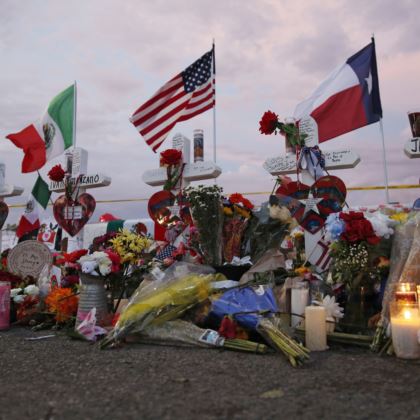

Flags fly over crosses at a makeshift memorial near the scene of a mass shooting at a shopping complex, Aug. 6, 2019, in El Paso, Texas. (AP)
VOA Special Report
Retail shootings
More than half of the retail mass shootings between 1966 and 2020 occurred in the past 14 years.
Mass shootings (1966 - February 2020)
The first retail shooting of the modern era took place in 1966 at a salon on a beauty school campus in Mesa, Arizona.
The shooter opened fire on a group of cosmetology students, and a customer and her children, killing five people, including a toddler.
The 1966 attack in Mesa was considered the first copycat mass shooting in the country. The perpetrator sought fame and appeared to emulate the massacre at the University of Texas, which took place three months earlier and received widespread media attention.
One in five mass shooters (22%) studied other mass shooters, according to The Violence Project, leading to a contagion effect in which one shooting can influence the next.
Mass shootings are defined by the Congressional Research Service as having four or more victims.
Shootings at retail establishments have taken place in every decade since the 1960s, but have increased in recent years.
More than half of the retail shootings between 1966 - February 2020 have occurred in the past 14 years, with venues, including a mall in Salt Lake City, Utah, a car wash in Saltlick Township, Pennsylvania, and a gas station in Detroit, Michigan.
The deadliest attack took place in 2019 at a Walmart in El Paso, Texas, near the border with Mexico. The shooter allegedly told police he was targeting Hispanics. Three Mexicans were among the 22 people killed in that attack. The shooter was charged with federal hate crimes.
Another prominent shooting took place outside a grocery store in Tucson, Arizona, in 2011. The perpetrator targeted a constituent meeting held in a supermarket parking lot attended by U.S. Congresswoman Gabrielle Giffords, who suffered a major brain injury. Six people died, and 13 others were injured.
Retail mass shooting locations Fatalities and retail location mass shootings
Circles scaled according to the number of fatalities.
Jillian Peterson, Ph.D., and James Densley, Ph.D., built a new database of mass shooters that they hope will inform future research and policy decisions about how to effectively prevent and respond to mass shootings.
For their study, they used the Congressional Research Service’s definition of a mass shooting:
“a multiple homicide incident in which four or more victims are murdered with firearms — not including the offender(s) — within one event, and at least some of the murders occurred in a public location or locations in close geographical proximity (e.g., a workplace, school, restaurant, or other public settings), and the murders are not attributable to any other underlying criminal activity or commonplace circumstance (armed robbery, criminal competition, insurance fraud, argument, or romantic triangle).”
About the data
All shooters have either been charged, convicted or killed at the scene.
The team collected more than 100 pieces of information on each of 172 mass shooters, resulting in The Violence Project Database of Mass Shootings in the United States, 1966 - February 2020.
They compiled details on hundreds of factors, including age, race, gender, nationality, sexual orientation, religion, education, relationship status, number of children, employment type and status, military service and branch, criminal, violence and abuse history, gang and terrorist affiliation, bullying, home environment and trauma.
What emerged were fleshed-out profiles and motivations of individual shooters, whose crimes can potentially influence current and future policy and prevention.
Retail shootings (1966 - February 2020)
While there is no single profile of a mass shooter, there are several similar characteristics of shooters who commit crimes at a retail establishment.
According to The Violence Project database, a retail shooter tends to be a white man, around 30 years old, with a criminal record and violent history. He usually has no connection to the location and tends to use one legally owned handgun.
Sixty-nine percent of retail shooters had a history of mental illnesses and a third (34%) had a thought disorder, which includes schizophrenia and psychosis. A quarter had a mood disorder, which includes depression and bipolar disorder.
Seventy-six percent had a criminal record, 31% had employment troubles and 21% served in the military.
Retail shooters are more likely to be strangers to their victims than shooters at most other locations. While more than 60% of mass shooters knew at least some of their victims, only 31% of retail shooters knew some of their victims.
Half of retail shooters were white and 45% were minorities. The average age of retail shooters is 34. That is higher than the average age of shooters who carried out killings at schools (18) or colleges (28), but lower than the average age of workplace shooters (38.5).